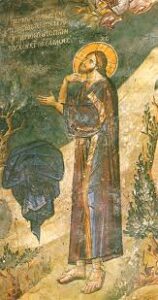 Students: For the benefit of any who were absent from class last week, let me explain again. Between now and Pascha we’re following the Church’s Sunday Scripture readings – appointed long centuries ago by the Fathers, designed to teach us how to keep Lent and prepare for the Feast of Feasts.
Students: For the benefit of any who were absent from class last week, let me explain again. Between now and Pascha we’re following the Church’s Sunday Scripture readings – appointed long centuries ago by the Fathers, designed to teach us how to keep Lent and prepare for the Feast of Feasts.
Since the story of the Canaanite Woman is such a difficult case, this week only I’ll include the text here. For other weeks your assignment will be to read the texts, as listed here, and then listen closely as they are read at Sunday Divine Liturgy.
Matthew 15:21-28
“At that time, Jesus went to the district of Tyre and Sidon. And behold, a Canaanite woman from that region came out and cried, “Have mercy on me, O Lord, Son of David; my daughter is severely possessed by a demon.” But he did not answer her a word. And his disciples came and begged him, saying, “Send her away, for she is crying after us.” He answered, “I was sent only to the lost sheep of the house of Israel.” But she came and knelt before  him, saying, “Lord, help me.” And he answered, “It is not fair to take the children’s bread and throw it to the dogs.” She said, “Yes, Lord, yet even the dogs eat the crumbs that fall from their master’s table.” Then Jesus answered her, “O woman, great is your faith! Be it done for you as you desire.” And her daughter was healed instantly.”
him, saying, “Lord, help me.” And he answered, “It is not fair to take the children’s bread and throw it to the dogs.” She said, “Yes, Lord, yet even the dogs eat the crumbs that fall from their master’s table.” Then Jesus answered her, “O woman, great is your faith! Be it done for you as you desire.” And her daughter was healed instantly.”
This image and the one below are from Peter Lastmann at Wikimedia Commons (Does anyone know the original sources?)
[See the first Comment below.]
Two questions:
Why in the world was our loving Lord Jesus so harsh with this poor woman?
How does this story help us get ready for Lent?
Why?
In the Methodist seminary I attended long ago, one of our New Testament professors was a professional skeptic. At the beginning of the term in September, he said he would first tear the Gospels apart, then put them back together again. Well, he did a great job with his first promise! However, In the spring, he was still busy demolishing. Just before Palm Sunday he “proved” to us that Jesus never rode into Jerusalem. “Happy Holy Week, class!”
However, he said believed the story of the Canaanite Woman was genuine, because “Why would anyone ever have made up such a nasty story about Jesus?”
Good point! It doesn’t seem at all like Him. And if you think Matthew is going to explain it, forget it.

For one thing, I’ve wondered if Jesus was just exasperated. He was fully human in all ways but sin, and being exasperated isn’t sinful. This would happen once later in His ministry: Remember when the Apostles couldn’t heal the epileptic boy. Matthew 17:17
If He was exasperated this week, He had good cause. He had just lost all patience with the Pharisees: “blind guides” leading the blind “into a pit”. Then the disciples couldn’t understand the obvious meaning of a parable, and He had cried, “Are you still so dull?”
Besides that, crowds were pressing Him continually, and He had such limited time to train His Apostles, and they were far from ready. So He had taken them north to “the district of Tyre and Sidon” (pagan turf, now southern Lebanon) so He could be alone with them. And what happens? Here comes this pagan woman after Him! Will we never get any time…?
Was that it? Or did this woman, for some reason, need to learn humility? Or…? I have no more guesses. If you have another explanation, please comment below.
For whatever reason, at first He treats this poor woman very shabbily. He ignores her, even though she calls Him “Son of David”, the promised “Messiah” – amazing words coming from the lips of a pagan.
The disciples beg Him: Send her away – she’s driving us up the wall. (I paraphrase.) Jesus answers “I was sent only to the lost sheep of the house of Israel”. Which was true: If pagans had been first to believe in Jesus, they would have said “Hooray! One more god! One more shrine. One more swing of the incense pot” – and Christianity would have got off to a false start. Jews alone believed in one God, Creator of heaven and earth. So if any Jews believed in Him, they would know that He must somehow be the One God in the flesh, for there is no other. Only after that was firmly established could the Apostles go out into the world, proclaiming first the One God, and then that Jesus of Nazareth is that One God Incarnate.
Yet still, the Lord took time for a few other pagans: He healed the daughter of the Roman Centurion, and the Gadarene demoniac(s). He spent much time with the Samaritan woman. Besides, how long would it have taken Him to heal this woman’s daughter? “An instant”, as it turned out. He could have saved a lot of time and bother if He’d just done that in the first place. It’s a mysery.
Then the woman comes and kneels before Him and cries “Yes, Lord, but even the dogs [some say the translation should be ‘puppies’] eat the crumbs that fall from their master’s table.” With that, Jesus’ heart seems to melt, and He heals her daughter “instantly”.
What can we learn from the Canaanite Woman?
Lent is our annual “shape up” period, “spring training” – the time for us to improve our spiritual lives, both internally and externally.
From this story the Church teaches us: How to pray for others (usually called intercession) and for ourselves, persistently and with faith. 
We’ll learn about some other kinds of prayer as we move on towards Pascha.
courtesy of Saint John the Evangelist Antiochian Church, Beaver Falls, Pennsylvania
I hope none here present are stuck with a childish attitude toward praying: “God, gimme what I want, and if You don’t, I’m not going to believe in You any more.” I suspect that’s at the root of much modern disbelief.
I hope we pray in an adult Christian way, with faith that God can grant us our desire, but also with faith that He who loves us will give us what is best, even though we may not know what it is. That is something God alone knows.
God may answer our prayers in three possible ways:
1 Yes, because we were asking for something good at the right time.
2 No, because we were asking for something wrong – perhaps despite our good intentions.
3 Wait, because we were asking for something good at the wrong time or for the wrong reasons. After all, our best and most fervent prayer is for everlasting life – and that He never grants (or at least we don’t know He has) till after we have died.
Praying with faith and persistence
Remember how Father Abraham begged God again and again to spare Sodom? “Lord, if there are fifty good men there” or forty? thirty? twenty? ten? will You not destroy it? Genesis 18:16-33 But God couldn’t find even ten, so His answer was No. He must have had His reasons.
 Remember the parable of the poor widow and the unjust judge. She chased after him again and again, even in the middle of the night, till finally he gave her what she wanted. “And will not God bring about justice for his chosen ones, who cry out to him day and night? Will he keep putting them off? I tell you, He will see that they get justice, and quickly.” Luke 18:1-8
Remember the parable of the poor widow and the unjust judge. She chased after him again and again, even in the middle of the night, till finally he gave her what she wanted. “And will not God bring about justice for his chosen ones, who cry out to him day and night? Will he keep putting them off? I tell you, He will see that they get justice, and quickly.” Luke 18:1-8
When our prayers are not granted, when it becomes hard to have faith in God and His love, why should we believe it? “Is it because Jesus is exasperated with me?” (I can’t think why He wouldn’t be!) Is He… this? Is He ….that? Do not even try to answer those questions. You’ll never know the answer, not yet. Go to the heart of the matter: Christ died for us. “Greater love has no man than that he should lay down his life for his friends.” John 15:13 And Christ is God: “He who has seen me has seen the Father.” John 14:9 That’s what God is like. That is how much God loves you. Start with that principle, and then work out from there.
 Next two icons with permission of Saint Isaac’s Skete at skete.com
Next two icons with permission of Saint Isaac’s Skete at skete.com
Our Lord Jesus Himself showed us how to pray. He did not want to die, certainly not in this excruciating way. He prayed, “Father, take this cup away from Me.” Then He prayed in faith: “Yet not what I will, but what You will.” That night in the Garden must have lasted a thousand years – yet He persisted. If this was His Father’s will, if it was the best thing for Him and for the world He loved, He would do it.
 Next day hanging on that Cross for an eternity, even though He knew He could come down, did He? For a moment He even felt He had been abandoned, that trusting His Father had all been a horrible mistake: “My God, my God, why have You forsaken me?” Yet He hung there in faith.
Next day hanging on that Cross for an eternity, even though He knew He could come down, did He? For a moment He even felt He had been abandoned, that trusting His Father had all been a horrible mistake: “My God, my God, why have You forsaken me?” Yet He hung there in faith.
Only after that came the Glory. But first came humble persistent submission in faith to His Father’s will.
During Lent, we amateurs need to learn to pray like that.
From the sublime to the ridiculous:
I hesitate to follow the powerful stories above with my infinitely cheaper ones. Nevertheless, I think my experience may be worth sharing. Here is how I began to learn about persisting in prayer, in faith.
Many years ago I was a restless Episcopalian priest. I knew something wasn’t right; I needed to be somewhere else. (I didn’t yet realize it was the Holy Orthodox Church.) Then out of the blue, a big parish I had never heard of contacted me, saying I was one of two finalists in their search for a pastor. (In the Episcopal Church, parishes call their priests. Bishops don’t appoint them.)
Since this was a job I hadn’t sought, I thought this might be the hand of the Lord. With my family I went and interviewed. I liked the parish and the people very much. It felt just right, and I was pretty well convinced it was the answer to what I’d been seeking.
So for one of the few times in my life I prayed specifically, prayed hard for what I wanted, that they would call me. I prayed and prayed and waited and waited, and finally the letter came: The other man had been selected.
I had assumed that if I didn’t get the job I would be dejected. To my great surprise I was happy. Why? Finally I figured it out: After all that prayer, if God didn’t give it to me, then it must have been for the best.
![]() And so it was. If I had gone there, very likely I would not have become Orthodox, and certainly Saint Nicholas Church, Cedarburg, would never have come into being – which was the second best thing * that happened to me in my whole life. That was the result when God said “no” to my fervent prayer.
And so it was. If I had gone there, very likely I would not have become Orthodox, and certainly Saint Nicholas Church, Cedarburg, would never have come into being – which was the second best thing * that happened to me in my whole life. That was the result when God said “no” to my fervent prayer.
- Marrying my wife was “first best”.
That’s how I learned to pray persistently with faith. How well have I done this since then? Don’t ask. But at least that taught me how to do it, got me headed in the right direction.
Why am I telling you all this? You’re probably better at it than I am.
How to intercede: a practical suggestion
Forgive me. I’m going to talk about my personal experience again.
The number of people on my intercession list has expanded almost astronomically over the years. Friends and loved ones keep moving on, so that my “departed” list is now even larger than my “living” list, which also keeps growing as I get to know new people. I have a written list, so I don’t forget anyone. I think it’s not necessary to provide specifics for each person. Believe it or not, God already knows what’s best for them! far better than we do. Therefore in most cases, I pray only “Lord, have mercy on N.”. In certain cases of great need, even though I think it’s audacious of me, I ask God to grant particular things, and then I try to trust.
Here’s something I’ve discovered: As I pray, often a couple of names “pop out” at me. (I don’t know how better to describe it.) This means I should get in touch with them, and almost invariably there’s a reason for it. Since my intercessory list is on my computer, I immediately send an email, and… just this morning, for example, someone popped out, so I emailed – and she’s sick with Covid and really needed to talk. I guess this practice is only for those who have a lot of time available! But it truly has been a wonder. As you intercede for others, you might want to open yourself up to this (very carefully *) and see what happens.
- People will not want you calling them every day saying “God just told me to talk to you”!
Conclusion
During Lent, learn from the Canaanite Woman to pray persistently, in faith. Never give up. Never give up. Never give up.
__________________________________
Next Week: First Sunday of Pre-Lent:
Epistle – about reading the Scriptures. Gospel – the Publican and the Pharisee.
Week after Next: Second Sunday of Pre-Lent:
Epistle – about Fasting. Gospel – the Prodigal Son.
Thank you Father!
The painting by Pieter Lastman is in the Rijksmuseum, Amsterdam.
Painted in 1617, it is oil on panel, 75 x 105 cm
Thank you, Father David.
Fr. Bill,
My understanding of Christ’s refusal to acknowledge the Canaanite Woman, and his seemingly harsh treatment of her, was to test and show her faith as an example, just as he did with the woman with the issue of blood. He didn’t reveal her identity to embarrass her, but again, to make an example of her faith.
Thank you, Father Constantine.
When I read the Gospel reading before church on Sunday (I use the Daily Readings app), I was a bit surprised at the way Jesus responded to her. Dogs, is he calling her a dog? Well, yes. Our parish priest basically said what you’ve written.
On the other hand, I’m glad to hear exasperation isn’t a sin 🙂
Christ said quite a number of startling things.